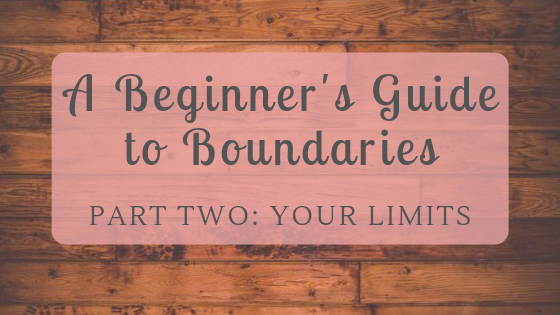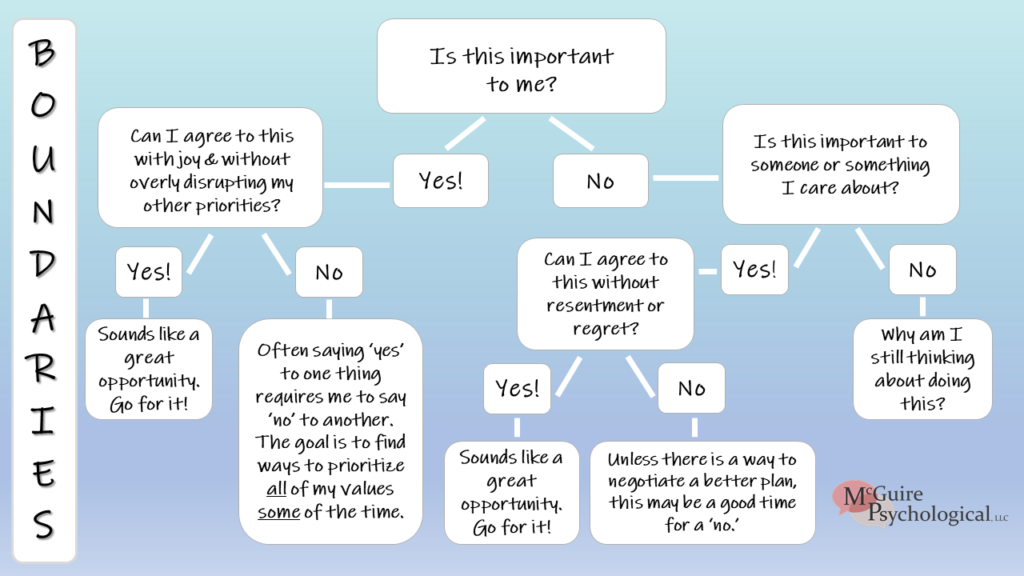Part Two: Identifying Your Limits

A Beginner’s Guide to Boundaries is a three-part series on this important topic. To start the process, I focused on identifying some of the myths about boundaries that I hear a lot. Now that I’ve shared about what boundaries aren’t, I’ll talk about what they are and help reshape your thinking about how they can work for you in your life. Lastly, once you have a good understanding of boundaries and their role in your well-being, we’ll focus on how to effectively communicate them to others. If you’re new to the topic, it can be a lot to sort out! But for those willing to hang in there, most of those I know who have done the work feel so grateful when they get to the other side of the experience and find things changed for the better.
In this second part of the three-part series, we will talk about what boundaries actually are and focus on strategies for beginning to identify and respecting your own personal boundaries as you make decisions about how to live your life. If you missed part one, The Myths of Boundary-Setting, it is a good starting point for understanding the why of setting good interpersonal boundaries and to prepare yourself for this second part, in which we will focus on the how.
At first glance, it may be tempting to think of setting boundaries in overly simplistic terms. Even efforts to define the concept vary widely, though. It’s not a simple thing to think about. For the purposes of being sure we have a shared working understanding as we talk about the issue, I find it helpful to think of boundaries as the limits we set and the agreements we make in relationships. When thinking about boundaries, it is important to remember that healthy, appropriate personal boundaries are neither absolute nor rigid. There are no rules which, when established, work in all circumstances, with all people, at all times. Boundaries require our ongoing attention and effort. Setting boundaries is both a flexible and continual process, in which you are thoughtfully and intentionally deciding if and when to agree to an experience, knowing your reasons for doing so (or not), and ensuring those reasons are meaningful and important to you.
Most people experience a large number of expectations from others in a given day. Boundaries allow us to be selective about when and how we agree to these expectations, and when and how to voice our disagreement and/or negotiate for an alternative. Examples of boundary-setting may include:
- Giving yourself permission to miss a friend’s event on an evening you already had other plans, rather than attempting to do both and feeling overwhelmed or exhausted by the experience
- Turning your phone to silent when with a loved one so you can focus on appreciating your time with them without interruption
- Respectfully discussing alternative ways you can help when asked to get involved with a service project in a role which you expect will be very difficult for you
- Checking and responding to work email only during business hours, despite regularly receiving communication from others outside of those times
- Making a personal decision, unpopular with some people close to you, about how you will enjoy a holiday
Considering your boundaries offers a flexible way of thinking about your wishes for your life. As discussed when reviewing common myths of boundaries, the goal is not to exclusively show concern for your own needs independent of the impact this has on others. When awareness of personal wishes, wants, and needs emerge as at least as important as the wants and needs of others, though, this often leads to a shift in choices we make about how we spend our time, what we agree to when asked by others, and how readily and/or regularly we sacrifice our own needs to meet the needs of others.
Good boundaries require ongoing awareness, evaluation, and decision-making. The rigid rules simply don’t work – for us or for others. So, instead, it is in our best interest to develop a reliable and trustworthy process for approaching each of these decisions thoughtfully. This process certainly gets easier over time and, eventually, may feel like second nature. Initially, though, using a decision tree or similar organizer may help you take a more systematic approach to honoring your own wants and needs at least as much as you respect and honor the wants and needs of others. When you can be intentional in this way, you are far more likely to engage with your life experiences from a place of enthusiasm and joy – as opposed to from a place of obligation and resentment – because you will know you have thoughtfully agreed to be involved in this situation in this way.
Try out this approach. Use the decision tree below to evaluate a (or a few) recent relational situation(s) which felt difficult for you to navigate.

What was it like for you to think about the situation in this way? Did you manage the situation in the way the decision tree arrived at, or differently? As you reflect on the situation, consider whether what you decided felt like the “right” choice for you in the end. This process of considering the facts, making a thoughtful decision, and reflecting on how it turned out is the “full-circle” process of good boundary-setting. You get to know more about yourself and your limits as you reflect on those times that have gone well and the times you have left a situation feeling less positively. With that information in hand, you make better decisions for yourself moving forward.
Many who identify themselves as “bad at boundaries” are struggling in the form of consistently elevating others’ needs above their own. However, it is important to be aware that boundaries are an issue of flexibility and balance, so it is entirely possible to struggle with boundaries in the form of consistently placing your own needs above those of others. Evaluating your decisions about boundaries will allow you better insight into how your boundary decisions affect you and those around you, in both helpful and unhelpful ways. Before attempting to make any changes in your life, give yourself an opportunity to spend some time evaluating your decisions using some form of strategic approach. Gather information about yourself, noting both your current areas of success and struggle with knowing your boundaries and making life decisions while taking them into account. Through this, you will likely find opportunities to congratulate yourself on ways you are handling this well, and you may find opportunities for small changes which could make a big difference.
pm